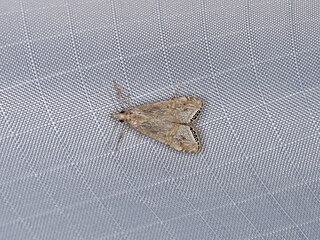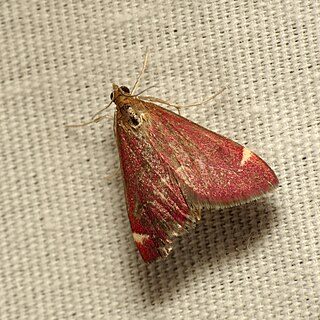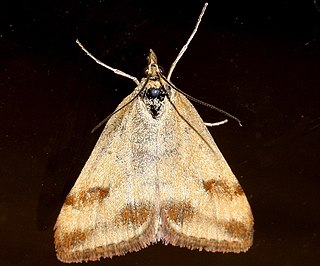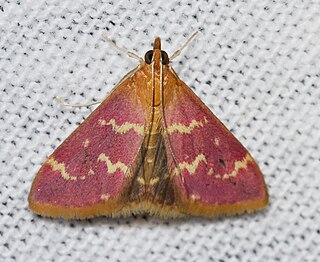Mimoschinia is a genus of moths of the family Crambidae. It contains only one species, Mimoschinia rufofascialis, the rufous-banded pyralid moth or barberpole caterpillar, which is found in the Caribbean, from Alberta to British Columbia, south to Texas and California and in Mexico.

Pyrausta is a specious genus of moths of the family Crambidae. The genus was erected by Franz von Paula Schrank in 1802.

Euchromius californicalis, the California grass-veneer, is a moth in the family Crambidae. It was described by Packard in 1873. It is found in North America, where it has been recorded from British Columbia, Alberta, Washington, Idaho, Montana, North Dakota, South Dakota, Oregon, Wyoming, California, Nevada, Utah, Colorado and New Mexico. The habitat consists of grasslands.
Pyrausta californicalis, the California pyrausta moth, is a moth in the family Crambidae. It was described by Alpheus Spring Packard in 1873. It is found in North America, where it has been recorded from British Columbia to California.
Pyrausta fodinalis is a moth in the family Crambidae. It was described by Julius Lederer in 1863. It is found in North America, where it has been recorded from British Columbia to Quebec and the north-eastern United States. It is also present in California, Nevada, Colorado and Wyoming. The habitat consists of undisturbed prairie and grassland areas.

Pyrausta grotei is a moth in the family Crambidae. It was described by Eugene G. Munroe in 1976. It is found in North America, where it has been recorded from Washington, Oregon, Montana, California, Utah, Colorado, Wyoming, Nevada, Arizona and Texas.
Pyrausta nicalis is a moth in the family Crambidae. It was described by Augustus Radcliffe Grote in 1878. It is found in North America, where it has been recorded from Quebec west to British Columbia, south to Colorado, Utah, Nevada and California.

Pyrausta perrubralis is a moth in the family Crambidae. It was described by Packard in 1873. It is found in North America, where it has been recorded from British Columbia, California, New Mexico, Oregon and Washington.

Pyrausta pseuderosnealis is a moth in the family Crambidae. It was described by Eugene G. Munroe in 1976. It is found in Mexico and the United States, where it has been recorded from California, Texas, Florida, Alabama, Georgia, Iowa, Mississippi, South Carolina, Louisiana, Arkansas, Missouri, Illinois and Oklahoma.
Pyrausta pseudonythesalis is a moth in the family Crambidae. It was described by Munroe in 1976. It is found in North America, where it has been recorded from California, Nevada, Arizona, New Mexico and Texas.
Pyrausta roseivestalis is a moth in the family Crambidae. It was described by Eugene G. Munroe in 1976. It is found in North America, where it has been recorded from California and southern Arizona.
Pyrausta scurralis is a moth in the family Crambidae. It was first observed and described by George Duryea Hulst in 1886. It is found in North America, where it has been recorded/reported in the Canadian provinces of Ontario, Manitoba and Saskatchewan to the US states, California, Arizona, and New Mexico and in Mexico. The habitat consists of undisturbed, shrubby aspen parkland.

Pyrausta semirubralis is a moth in the family Crambidae. It was described by Alpheus Spring Packard in 1873. It is found in North America, where it has been recorded from southern British Columbia to California, Nevada, Colorado and Arizona. The habitat consists of coastal areas, reaching inland up to altitudes of about 9000 ft.

Pyrausta signatalis, the raspberry pyrausta moth, is a moth in the family Crambidae. It was described by Francis Walker in 1866. It is found in North America, where it has been recorded from British Columbia to Ontario, south to North Carolina, South Carolina, Texas and Arizona. The habitat consists of aspen parkland and grasslands.
Pyrausta socialis, the sociable pyrausta moth, is a moth in the family Crambidae. It was described by Augustus Radcliffe Grote in 1877. It is found in North America, where it has been recorded from Ontario west to British Columbia, south to Montana and Colorado.
Pyrausta subsequalis is a moth in the family Crambidae. It was described by Achille Guenée in 1854. It is found in North America, where it has been recorded from southern Alberta and southern British Columbia south to Arizona and New Mexico. The habitat consists of dry prairie areas.
Pyrausta tuolumnalis is a moth in the family Crambidae. It was described by William Barnes and James Halliday McDunnough in 1918. It is found in North America, where it has been recorded from the western Northwest Territories and Yukon, south through British Columbia and Alberta to the mountains of California and New Mexico. The habitat consists of forested areas in the mountains.
Pyrausta borealis, the northern pyrausta moth, is a moth in the family Crambidae. It was described by Packard in 1867. It is found in North America, where it has been recorded from Newfoundland and Labrador west to British Columbia, north to Alaska and the Yukon. The habitat consists of boreal forests.
Mecyna mustelinalis is a moth in the family Crambidae. It was described by Packard in 1873. It is found in North America, where it has been recorded from Alberta, Arizona, British Columbia, California, Manitoba, Montana, Nevada, Saskatchewan, Utah, Washington and Yukon.

Udea itysalis is a moth in the family Crambidae. It was described by Francis Walker in 1859. It is found in North America, where it has been recorded from British Columbia to Quebec, south to Colorado, California, Nevada and Arizona. It has also been recorded from the Sayan Mountains in Russia.








